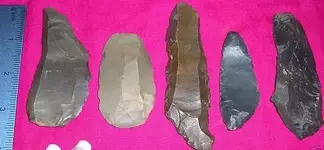uniface
Silver Member
- Joined
- Jun 4, 2009
- Messages
- 3,216
- Reaction score
- 2,905
- Golden Thread
- 0
- Location
- Central Pennsylvania
- Primary Interest:
- Other
Not very often any more, but every once in a while something really exciting turns up and flies under the radar.
Like these from Benton Co., Tennessee.
Scored them yesterday.Two definite paleos (1 & 3), two "maybes (2 & 5)," and an ambiguous one ('til I see the other side).
Searching for these is a not often successful quest, but it keeps me out of bar rooms and billiard parlors


Like these from Benton Co., Tennessee.
Scored them yesterday.Two definite paleos (1 & 3), two "maybes (2 & 5)," and an ambiguous one ('til I see the other side).
Searching for these is a not often successful quest, but it keeps me out of bar rooms and billiard parlors



Attachments
Upvote
0




